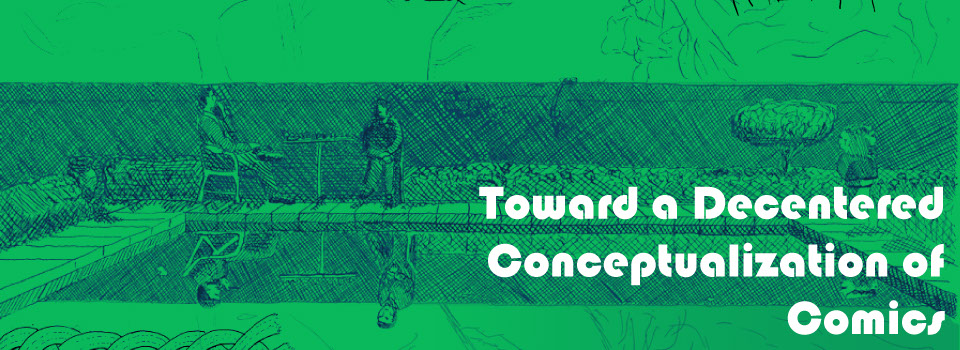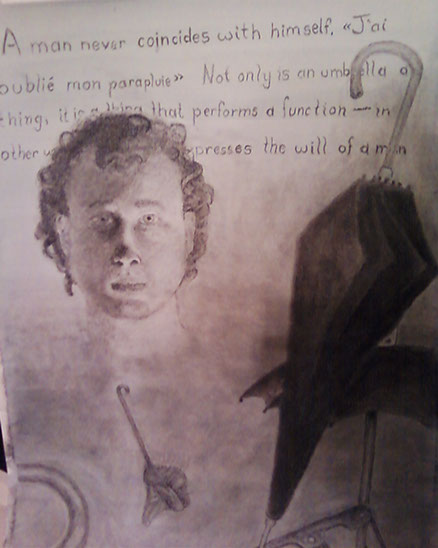
x
Contents
Home
Home
Home

The Outside Is the Inside

"A feminine text cannot fail to be more than subversive." (Cixous 888)

distinction or paralogy?

or does it?

language's inception

[tree]
木

Le Pli

textile texture
We move now to Jacques Derrida. While I utilize Derrida’s methodologies of research and theory I am also slightly ambivalent about his theories of language. My issue with Derrida’s theory of language may actually be illusory, but I think it worth stating. In Of Grammatology Derrida explicates the differences between speech and writing, arguing against common sense that the latter may precede the former. The entire argument depends upon the play of presence and absence, explicated in a truncated form in his term différance. Finally he brings us to his boldest and most controversial statement: “There is no outside-text” (158).
Derrida’s statement in Of Grammatology, is translated “there is nothing outside of the text” (italics in original), but the translator, Gayatri Spivak, helpfully adds the original French and an alternate translation: “there is no outside-text; il n’y a pas de hors-texte” (158). These two translations lead to two radically opposed interpretations. The first hears Derrida saying that there is no real world outside of language. The second hears Derrida saying that there is no metalinguistic or metatextual position from which to evaluate language. No stable point of absolute knowledge that is always already (con)textualized. The first has marred the American reception of deconstruction (as well as post-structuralism and postmodernism), leading Derrida’s opponents (and some of his followers) to claim that Derrida is a nihilist or idealist who only believes there is truly nothing outside of language. Derrida has gone to great pains to endorse the second reading and distance himself from the first. We see this in the attention he pays to paraverbal components like layout (Glas and Dissemination) and painting (The Truth in Painting).
Regardless, my own battle depends more upon what is meant by text in this formulation. Derrida has already complicated its definition throughout this work (and others). Suffice to say, I am uncomfortable with the word because I fear it might return us to a kind of logocentrism; however, I also embrace its evocation of textile weaving, folding complications. An easy way to answer my fears is to exclude it by following Foucault’s formulation instead: “There is no outside” (Discipline and Punish 35). I realize that this act of cowardice on my part is not particularly respectable, and when we get to Lyotard I will become more courageous. Consider this, then, a moment’s hesitation.
Nevertheless, Derrida remedied this ambiguity in an interview with Maurizio Ferraris:
I take great interest in questions of language and rhetoric, and I think they deserve enormous consideration; but there is a point where the authority of final jurisdiction is neither rhetorical nor linguistic, nor even discursive. The notion of trace or of text is introduced to mark the limits of the linguistic turn. This is one more reason why I prefer to speak of “mark” rather than of language. In the first place the mark is not anthropological; it is prelinguistic; it is the possibility of language, and it is everywhere there is a relation to another thing or relation to an other. For such relations, the mark has no need of language. (Derrida and Ferraris 76)
This prelinguistic mark is the grammè: the mark, writing, the trace. It is the moment of différance and its effects become what is called text. Derrida’s notion of the figural, at least within Of Grammatology, is illusory, elusive (note the puns on the Latin word for play, ludo, lusus, which will continue). The image is for the most part presented as a moment of the grammè: a moment between speechlessness and alphabet, a hypothetical unreachable origin.
In the final chapter of Of Grammatology, Derrida is tying up loose ends; enough with complication, now he must imply and explicate. His long repartee with Rousseau leads him to a short parry with Condillac, whose conceptualization of universal grammar and its script assumes an origin:
Like the first word, the first pictogram is therefore an image, both in the sense of imitative representation and of metaphoric displacement. The interval between the thing itself and its reproduction, however faithful, is traversed only by transference. The first sign is determined as an image. The idea has an essential relationship to the sign, the representative substitution of sensation. (282)
The original script, pictograms, resembles what it represents. We saw this in Saussure’s sign. The signifier and signified are divided by an insurmountable gap: the represented does not resemble the representation. But there are examples in which the represented does resemble the representation. In written Chinese (and the many Asian scripts influenced by Chinese), the character that represents tree looks like a tree: 木. We do not have to look to hieroglyphics, kanji, or cuneiform here; featural alphabets like Hangul crop up within recorded history. Hangul was created in the fifteenth Century by the Korean king Sejong as an alphabet for the people (in opposition to the complex Chinese-influenced script of the aristocracy). In Hangul the letters resemble the shape of the speaker’s mouth as she or he makes the sound represented. Thus the Hangul letter that represents L looks like a tongue being pulled back and up in the mouth: ㄹ. For Derrida, this might be one more attempt to make representation presence, but it too operates through the same play of presence and absence seen in all representation.
As we move to accept Derrida’s play along the chain of signification we find that the gap itself is where his interest lies. Différance is not in the gap but rather is the gap. Whereas Rousseau’s (and Condillac’s) argument depends on presence, Derrida shows us that presence cannot exist without absence, the two in constant play:
But the catastrophe that interrupted the state of nature opens the movements of distancing which brings closer; perfect representation should represent perfectly. It restores presence and effaces itself as absolute representation. This movement is necessary. The telos of the image is its own imperceptibility. When the perfect image ceases to be other than the thing, it represents the thing and restores originary presence. Indefinite cycle: represented source of representation, the origin of the image can in turn represent its representers, replace its substitutes, supply its supplements. Folded, returning to itself, representing itself, sovereign, presence is then—and barely—only the supplement of a supplement. (297-98)
Here we see différance,* the differentiation that is at once a schism and a deferral. The difference of différance becomes entwined with the dual eyes of the parallax, while the constructed absent reality present within the mind figures deferral.
Thus Derrida presents us with three key ideas: there is no outside-text (that is to say, we cannot appeal to a position outside of language that will once and for all establish meaning), resemblance is derivative of representation (not vice versa), and any attempt to fix the gap between signifier and signified is doomed to fail.
Alongside these three we have a fourth key point crucial to understanding Derrida’s framework: the center that is no center. This center cannot be seen directly, but only peripherally. The structure depends upon it. The sign gives it meaning (so long as we forget the play along the chain of signification). Play swirls us back toward this center, at times moving the center itself. This mode of periphery, of a center that is no center may be seen in the trace, a quasi-transcendental origin that is no origin:
differences appear among the elements or rather produce them, make them emerge as such and constitute the texts, the chains, and the systems of traces. These chains and systems cannot be outlined except in the fabric of this trace or imprint. The unheard difference between the appearing and the appearance (between the “world” and “lived experience”) is the condition of all other differences, of all other traces, and it is already a trace. This last concept is thus absolutely and by rights “anterior” to all physiological problematics concerning the nature of the engramme [the unit of engraving], or metaphysical problematics concerning the meaning of absolute presence whose trace is thus opened to deciphering. The trace is in fact the absolute origin of sense in general. Which amounts to saying once again that there is no origin of sense in general. The trace is the différance which opens appearance and signification. (65)
Through the trace, writing may be seen as prior to speaking: the trace proceeds all metaphysics, all attempts to describe it. And with the trace we come to comics. I too am merely a tracer, adding depth to the work of one who has gone before me. I have here traced he who traced the trace. Derrida’s methodology then comprises periphery and parallax, but it also gives me a more practical mode:
If the simulacrum is ever going to occur, its writing must be in the interval between several styles. And the insinuation of the woman (of) Nietzsche is that, if there is going to be style, there can only be more than one. (Spurs 139)
This simulacrum, the forgotten umbrella, calls for an interplay of styles and modes, of image and text. We will return to Derrida later in this nexus, as he returns to the question of resemblance in later works, but for now we will examine Lyotard’s implicit critique of Of Grammatology’s perceived logo- or graphocentrism.
*The gap is crucial to deconstructive thought and to comics. We saw that McCloud and Eisner wish to fix the gap as the gutter, the area between panels. I however move it to the gap between sense and sign, visual and verbal. Put in the language of comics, the difference is between interpanel and intrapanel gaps. McCloud and Eisner’s focus on interpanel gaps reduces comics to time stretched across space. My own emphasis on Intrapanel participation shows us that each panel forces its own deconstruction. Catherine Labio offers a fuller explanation of how gutters “fulfill a multiplicity of functions” that cannot be reduced to absence (335).
Etymology Fun!
This network of words descends from the Latin plectō, meaning “to plait, braid.” Its sister, plicō, means “to fold,” and descends from the same Greek verb: plekw, which means, “to plait, twine, twist, weave, braid…metaph[orically] to plan, devise, contrive.” The original Greek verb, plekw, split into two distinct meanings in Latin, but rather than differentiating the metaphorical from the literal, each word retained both aspects. From plectō we get “plexus” and “complex”, whereas plicō yields both “explicate” and “explicit.” This particular lexical node entails the concepts of planning and folding. When a critic explicates a passage the author’s original complex plans are unraveled before the reader—the latently metatextual becomes patent. All future puns may be inferred by the reader with the author’s willing permission—not that you needed it.

Self-portrait by the author.

